Case Study: Clinical Reasoning and Management of Patient Deterioration
VerifiedAdded on 2022/11/13
|9
|2514
|441
Case Study
AI Summary
This case study examines the clinical deterioration of a 62-year-old patient admitted with pyelonephritis, a condition involving kidney inflammation due to bacterial infection, and a history of hypertension and depression. The patient experienced hypotension and distributive shock. The report follows the clinical reasoning cycle, detailing the patient's condition, the collection of cues, and the processing of information. The problem was identified as distributive shock, linked to the patient's medical history and current diagnosis. Interventions included oxygen administration, IV fluids, and monitoring vital signs. Outcomes were evaluated, showing improvement in blood pressure, heart rate, and respiratory rate. The reflection emphasizes the importance of rapid response, effective communication, and careful patient handling. The assignment underscores the practical application of clinical reasoning in managing critically ill patients.

Students name;
Institutional affliation;
Institutional affliation;
Paraphrase This Document
Need a fresh take? Get an instant paraphrase of this document with our AI Paraphraser
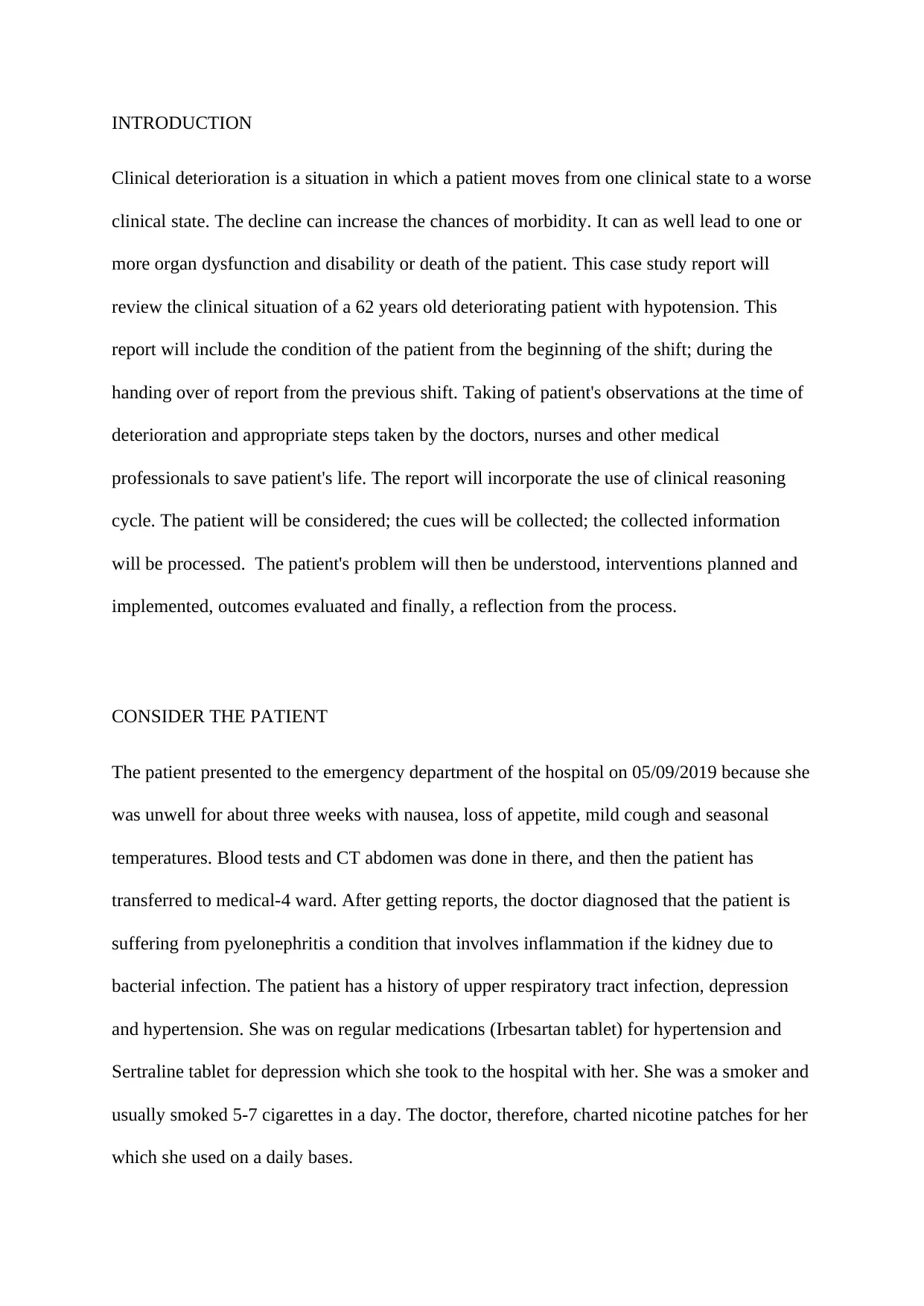
INTRODUCTION
Clinical deterioration is a situation in which a patient moves from one clinical state to a worse
clinical state. The decline can increase the chances of morbidity. It can as well lead to one or
more organ dysfunction and disability or death of the patient. This case study report will
review the clinical situation of a 62 years old deteriorating patient with hypotension. This
report will include the condition of the patient from the beginning of the shift; during the
handing over of report from the previous shift. Taking of patient's observations at the time of
deterioration and appropriate steps taken by the doctors, nurses and other medical
professionals to save patient's life. The report will incorporate the use of clinical reasoning
cycle. The patient will be considered; the cues will be collected; the collected information
will be processed. The patient's problem will then be understood, interventions planned and
implemented, outcomes evaluated and finally, a reflection from the process.
CONSIDER THE PATIENT
The patient presented to the emergency department of the hospital on 05/09/2019 because she
was unwell for about three weeks with nausea, loss of appetite, mild cough and seasonal
temperatures. Blood tests and CT abdomen was done in there, and then the patient has
transferred to medical-4 ward. After getting reports, the doctor diagnosed that the patient is
suffering from pyelonephritis a condition that involves inflammation if the kidney due to
bacterial infection. The patient has a history of upper respiratory tract infection, depression
and hypertension. She was on regular medications (Irbesartan tablet) for hypertension and
Sertraline tablet for depression which she took to the hospital with her. She was a smoker and
usually smoked 5-7 cigarettes in a day. The doctor, therefore, charted nicotine patches for her
which she used on a daily bases.
Clinical deterioration is a situation in which a patient moves from one clinical state to a worse
clinical state. The decline can increase the chances of morbidity. It can as well lead to one or
more organ dysfunction and disability or death of the patient. This case study report will
review the clinical situation of a 62 years old deteriorating patient with hypotension. This
report will include the condition of the patient from the beginning of the shift; during the
handing over of report from the previous shift. Taking of patient's observations at the time of
deterioration and appropriate steps taken by the doctors, nurses and other medical
professionals to save patient's life. The report will incorporate the use of clinical reasoning
cycle. The patient will be considered; the cues will be collected; the collected information
will be processed. The patient's problem will then be understood, interventions planned and
implemented, outcomes evaluated and finally, a reflection from the process.
CONSIDER THE PATIENT
The patient presented to the emergency department of the hospital on 05/09/2019 because she
was unwell for about three weeks with nausea, loss of appetite, mild cough and seasonal
temperatures. Blood tests and CT abdomen was done in there, and then the patient has
transferred to medical-4 ward. After getting reports, the doctor diagnosed that the patient is
suffering from pyelonephritis a condition that involves inflammation if the kidney due to
bacterial infection. The patient has a history of upper respiratory tract infection, depression
and hypertension. She was on regular medications (Irbesartan tablet) for hypertension and
Sertraline tablet for depression which she took to the hospital with her. She was a smoker and
usually smoked 5-7 cigarettes in a day. The doctor, therefore, charted nicotine patches for her
which she used on a daily bases.
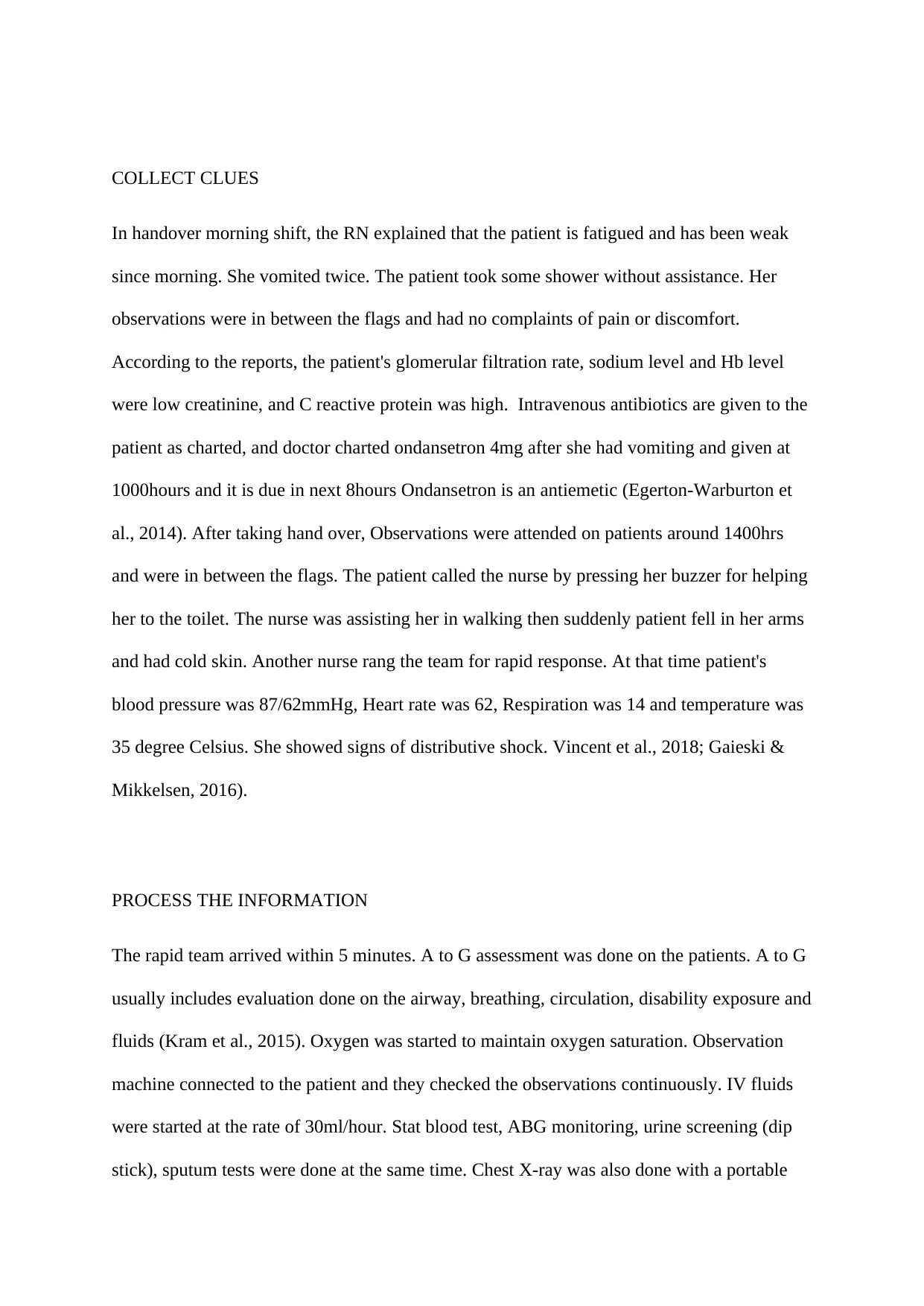
COLLECT CLUES
In handover morning shift, the RN explained that the patient is fatigued and has been weak
since morning. She vomited twice. The patient took some shower without assistance. Her
observations were in between the flags and had no complaints of pain or discomfort.
According to the reports, the patient's glomerular filtration rate, sodium level and Hb level
were low creatinine, and C reactive protein was high. Intravenous antibiotics are given to the
patient as charted, and doctor charted ondansetron 4mg after she had vomiting and given at
1000hours and it is due in next 8hours Ondansetron is an antiemetic (Egerton-Warburton et
al., 2014). After taking hand over, Observations were attended on patients around 1400hrs
and were in between the flags. The patient called the nurse by pressing her buzzer for helping
her to the toilet. The nurse was assisting her in walking then suddenly patient fell in her arms
and had cold skin. Another nurse rang the team for rapid response. At that time patient's
blood pressure was 87/62mmHg, Heart rate was 62, Respiration was 14 and temperature was
35 degree Celsius. She showed signs of distributive shock. Vincent et al., 2018; Gaieski &
Mikkelsen, 2016).
PROCESS THE INFORMATION
The rapid team arrived within 5 minutes. A to G assessment was done on the patients. A to G
usually includes evaluation done on the airway, breathing, circulation, disability exposure and
fluids (Kram et al., 2015). Oxygen was started to maintain oxygen saturation. Observation
machine connected to the patient and they checked the observations continuously. IV fluids
were started at the rate of 30ml/hour. Stat blood test, ABG monitoring, urine screening (dip
stick), sputum tests were done at the same time. Chest X-ray was also done with a portable
In handover morning shift, the RN explained that the patient is fatigued and has been weak
since morning. She vomited twice. The patient took some shower without assistance. Her
observations were in between the flags and had no complaints of pain or discomfort.
According to the reports, the patient's glomerular filtration rate, sodium level and Hb level
were low creatinine, and C reactive protein was high. Intravenous antibiotics are given to the
patient as charted, and doctor charted ondansetron 4mg after she had vomiting and given at
1000hours and it is due in next 8hours Ondansetron is an antiemetic (Egerton-Warburton et
al., 2014). After taking hand over, Observations were attended on patients around 1400hrs
and were in between the flags. The patient called the nurse by pressing her buzzer for helping
her to the toilet. The nurse was assisting her in walking then suddenly patient fell in her arms
and had cold skin. Another nurse rang the team for rapid response. At that time patient's
blood pressure was 87/62mmHg, Heart rate was 62, Respiration was 14 and temperature was
35 degree Celsius. She showed signs of distributive shock. Vincent et al., 2018; Gaieski &
Mikkelsen, 2016).
PROCESS THE INFORMATION
The rapid team arrived within 5 minutes. A to G assessment was done on the patients. A to G
usually includes evaluation done on the airway, breathing, circulation, disability exposure and
fluids (Kram et al., 2015). Oxygen was started to maintain oxygen saturation. Observation
machine connected to the patient and they checked the observations continuously. IV fluids
were started at the rate of 30ml/hour. Stat blood test, ABG monitoring, urine screening (dip
stick), sputum tests were done at the same time. Chest X-ray was also done with a portable
⊘ This is a preview!⊘
Do you want full access?
Subscribe today to unlock all pages.

Trusted by 1+ million students worldwide
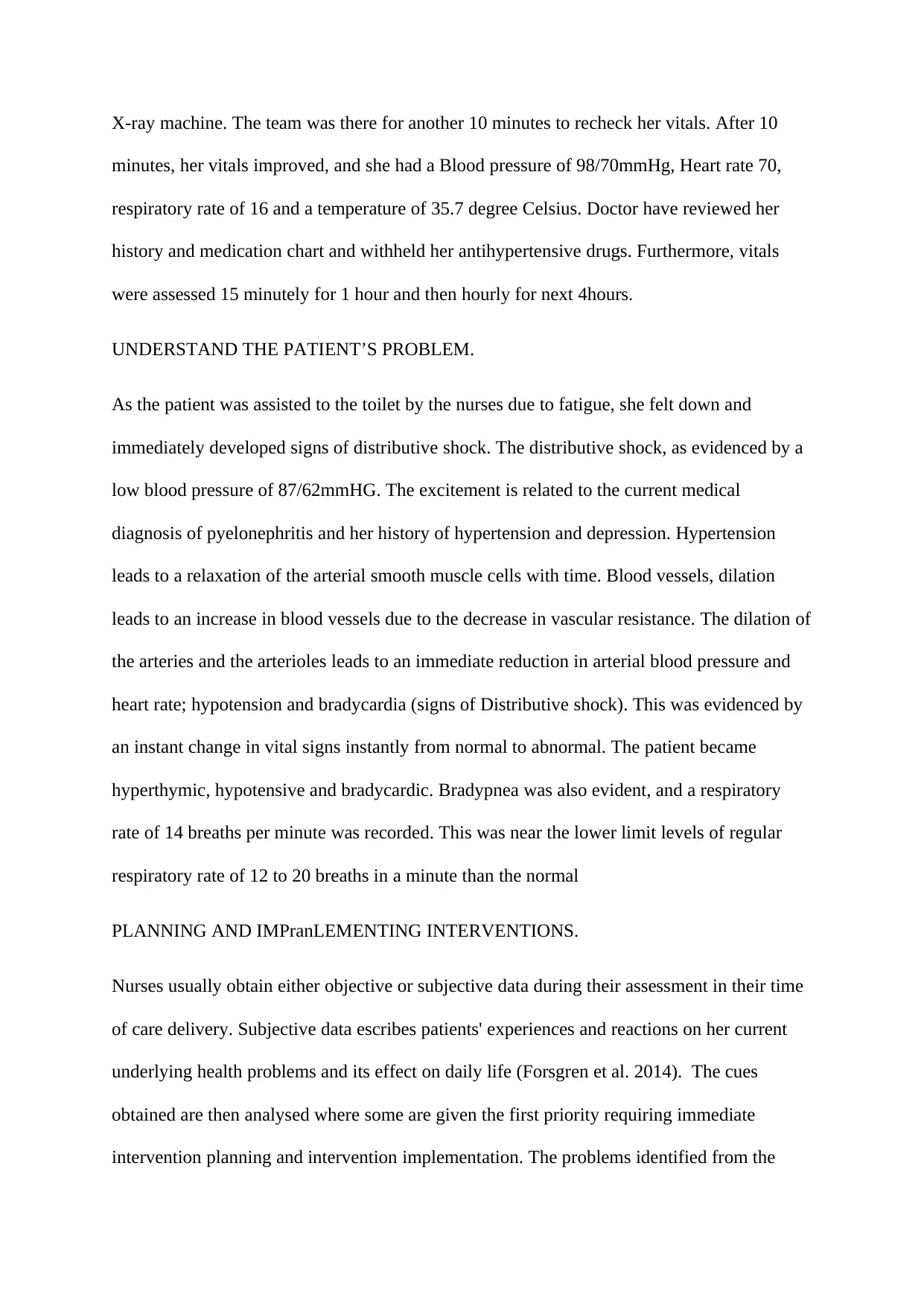
X-ray machine. The team was there for another 10 minutes to recheck her vitals. After 10
minutes, her vitals improved, and she had a Blood pressure of 98/70mmHg, Heart rate 70,
respiratory rate of 16 and a temperature of 35.7 degree Celsius. Doctor have reviewed her
history and medication chart and withheld her antihypertensive drugs. Furthermore, vitals
were assessed 15 minutely for 1 hour and then hourly for next 4hours.
UNDERSTAND THE PATIENT’S PROBLEM.
As the patient was assisted to the toilet by the nurses due to fatigue, she felt down and
immediately developed signs of distributive shock. The distributive shock, as evidenced by a
low blood pressure of 87/62mmHG. The excitement is related to the current medical
diagnosis of pyelonephritis and her history of hypertension and depression. Hypertension
leads to a relaxation of the arterial smooth muscle cells with time. Blood vessels, dilation
leads to an increase in blood vessels due to the decrease in vascular resistance. The dilation of
the arteries and the arterioles leads to an immediate reduction in arterial blood pressure and
heart rate; hypotension and bradycardia (signs of Distributive shock). This was evidenced by
an instant change in vital signs instantly from normal to abnormal. The patient became
hyperthymic, hypotensive and bradycardic. Bradypnea was also evident, and a respiratory
rate of 14 breaths per minute was recorded. This was near the lower limit levels of regular
respiratory rate of 12 to 20 breaths in a minute than the normal
PLANNING AND IMPranLEMENTING INTERVENTIONS.
Nurses usually obtain either objective or subjective data during their assessment in their time
of care delivery. Subjective data escribes patients' experiences and reactions on her current
underlying health problems and its effect on daily life (Forsgren et al. 2014). The cues
obtained are then analysed where some are given the first priority requiring immediate
intervention planning and intervention implementation. The problems identified from the
minutes, her vitals improved, and she had a Blood pressure of 98/70mmHg, Heart rate 70,
respiratory rate of 16 and a temperature of 35.7 degree Celsius. Doctor have reviewed her
history and medication chart and withheld her antihypertensive drugs. Furthermore, vitals
were assessed 15 minutely for 1 hour and then hourly for next 4hours.
UNDERSTAND THE PATIENT’S PROBLEM.
As the patient was assisted to the toilet by the nurses due to fatigue, she felt down and
immediately developed signs of distributive shock. The distributive shock, as evidenced by a
low blood pressure of 87/62mmHG. The excitement is related to the current medical
diagnosis of pyelonephritis and her history of hypertension and depression. Hypertension
leads to a relaxation of the arterial smooth muscle cells with time. Blood vessels, dilation
leads to an increase in blood vessels due to the decrease in vascular resistance. The dilation of
the arteries and the arterioles leads to an immediate reduction in arterial blood pressure and
heart rate; hypotension and bradycardia (signs of Distributive shock). This was evidenced by
an instant change in vital signs instantly from normal to abnormal. The patient became
hyperthymic, hypotensive and bradycardic. Bradypnea was also evident, and a respiratory
rate of 14 breaths per minute was recorded. This was near the lower limit levels of regular
respiratory rate of 12 to 20 breaths in a minute than the normal
PLANNING AND IMPranLEMENTING INTERVENTIONS.
Nurses usually obtain either objective or subjective data during their assessment in their time
of care delivery. Subjective data escribes patients' experiences and reactions on her current
underlying health problems and its effect on daily life (Forsgren et al. 2014). The cues
obtained are then analysed where some are given the first priority requiring immediate
intervention planning and intervention implementation. The problems identified from the
Paraphrase This Document
Need a fresh take? Get an instant paraphrase of this document with our AI Paraphraser
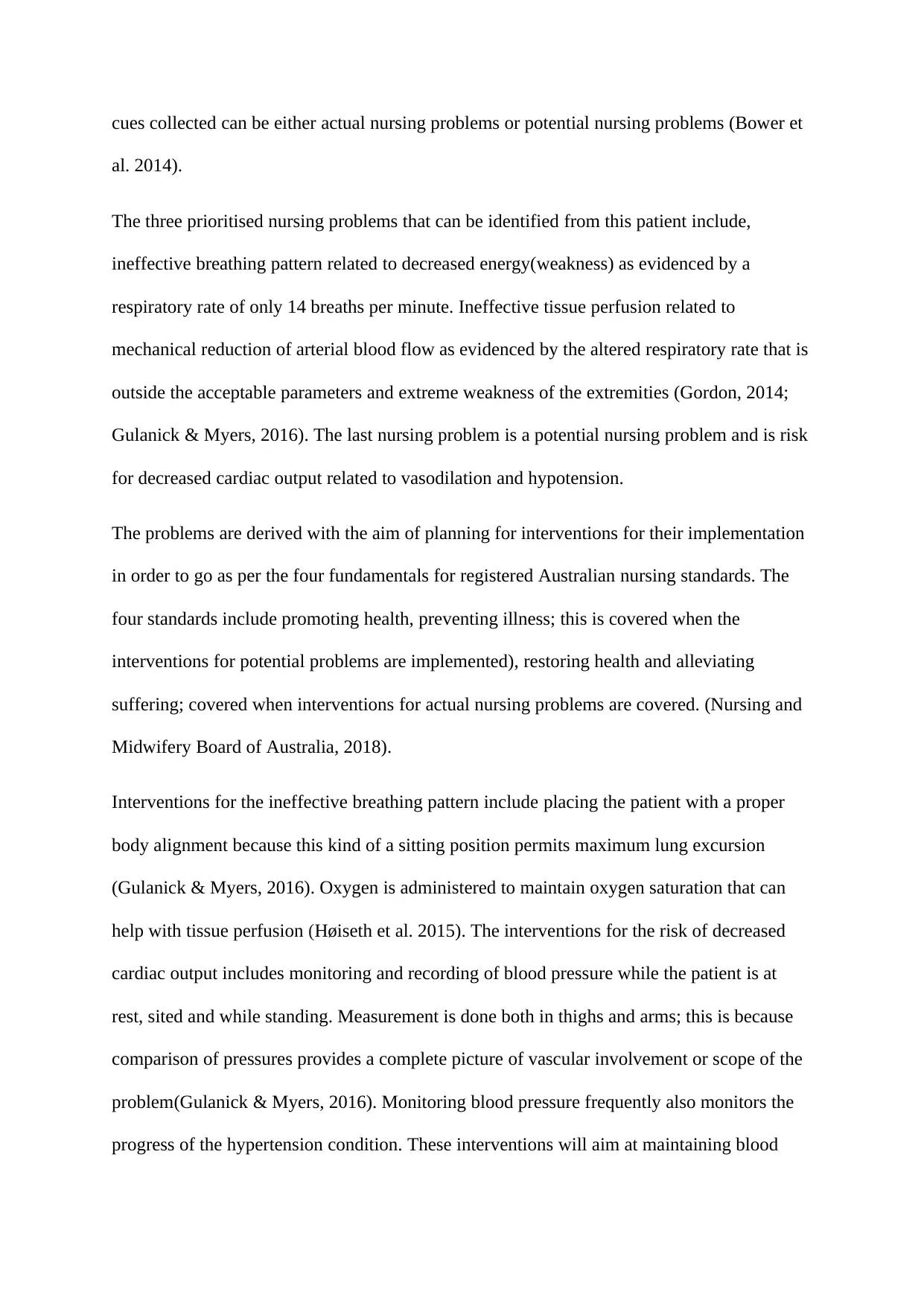
cues collected can be either actual nursing problems or potential nursing problems (Bower et
al. 2014).
The three prioritised nursing problems that can be identified from this patient include,
ineffective breathing pattern related to decreased energy(weakness) as evidenced by a
respiratory rate of only 14 breaths per minute. Ineffective tissue perfusion related to
mechanical reduction of arterial blood flow as evidenced by the altered respiratory rate that is
outside the acceptable parameters and extreme weakness of the extremities (Gordon, 2014;
Gulanick & Myers, 2016). The last nursing problem is a potential nursing problem and is risk
for decreased cardiac output related to vasodilation and hypotension.
The problems are derived with the aim of planning for interventions for their implementation
in order to go as per the four fundamentals for registered Australian nursing standards. The
four standards include promoting health, preventing illness; this is covered when the
interventions for potential problems are implemented), restoring health and alleviating
suffering; covered when interventions for actual nursing problems are covered. (Nursing and
Midwifery Board of Australia, 2018).
Interventions for the ineffective breathing pattern include placing the patient with a proper
body alignment because this kind of a sitting position permits maximum lung excursion
(Gulanick & Myers, 2016). Oxygen is administered to maintain oxygen saturation that can
help with tissue perfusion (Høiseth et al. 2015). The interventions for the risk of decreased
cardiac output includes monitoring and recording of blood pressure while the patient is at
rest, sited and while standing. Measurement is done both in thighs and arms; this is because
comparison of pressures provides a complete picture of vascular involvement or scope of the
problem(Gulanick & Myers, 2016). Monitoring blood pressure frequently also monitors the
progress of the hypertension condition. These interventions will aim at maintaining blood
al. 2014).
The three prioritised nursing problems that can be identified from this patient include,
ineffective breathing pattern related to decreased energy(weakness) as evidenced by a
respiratory rate of only 14 breaths per minute. Ineffective tissue perfusion related to
mechanical reduction of arterial blood flow as evidenced by the altered respiratory rate that is
outside the acceptable parameters and extreme weakness of the extremities (Gordon, 2014;
Gulanick & Myers, 2016). The last nursing problem is a potential nursing problem and is risk
for decreased cardiac output related to vasodilation and hypotension.
The problems are derived with the aim of planning for interventions for their implementation
in order to go as per the four fundamentals for registered Australian nursing standards. The
four standards include promoting health, preventing illness; this is covered when the
interventions for potential problems are implemented), restoring health and alleviating
suffering; covered when interventions for actual nursing problems are covered. (Nursing and
Midwifery Board of Australia, 2018).
Interventions for the ineffective breathing pattern include placing the patient with a proper
body alignment because this kind of a sitting position permits maximum lung excursion
(Gulanick & Myers, 2016). Oxygen is administered to maintain oxygen saturation that can
help with tissue perfusion (Høiseth et al. 2015). The interventions for the risk of decreased
cardiac output includes monitoring and recording of blood pressure while the patient is at
rest, sited and while standing. Measurement is done both in thighs and arms; this is because
comparison of pressures provides a complete picture of vascular involvement or scope of the
problem(Gulanick & Myers, 2016). Monitoring blood pressure frequently also monitors the
progress of the hypertension condition. These interventions will aim at maintaining blood
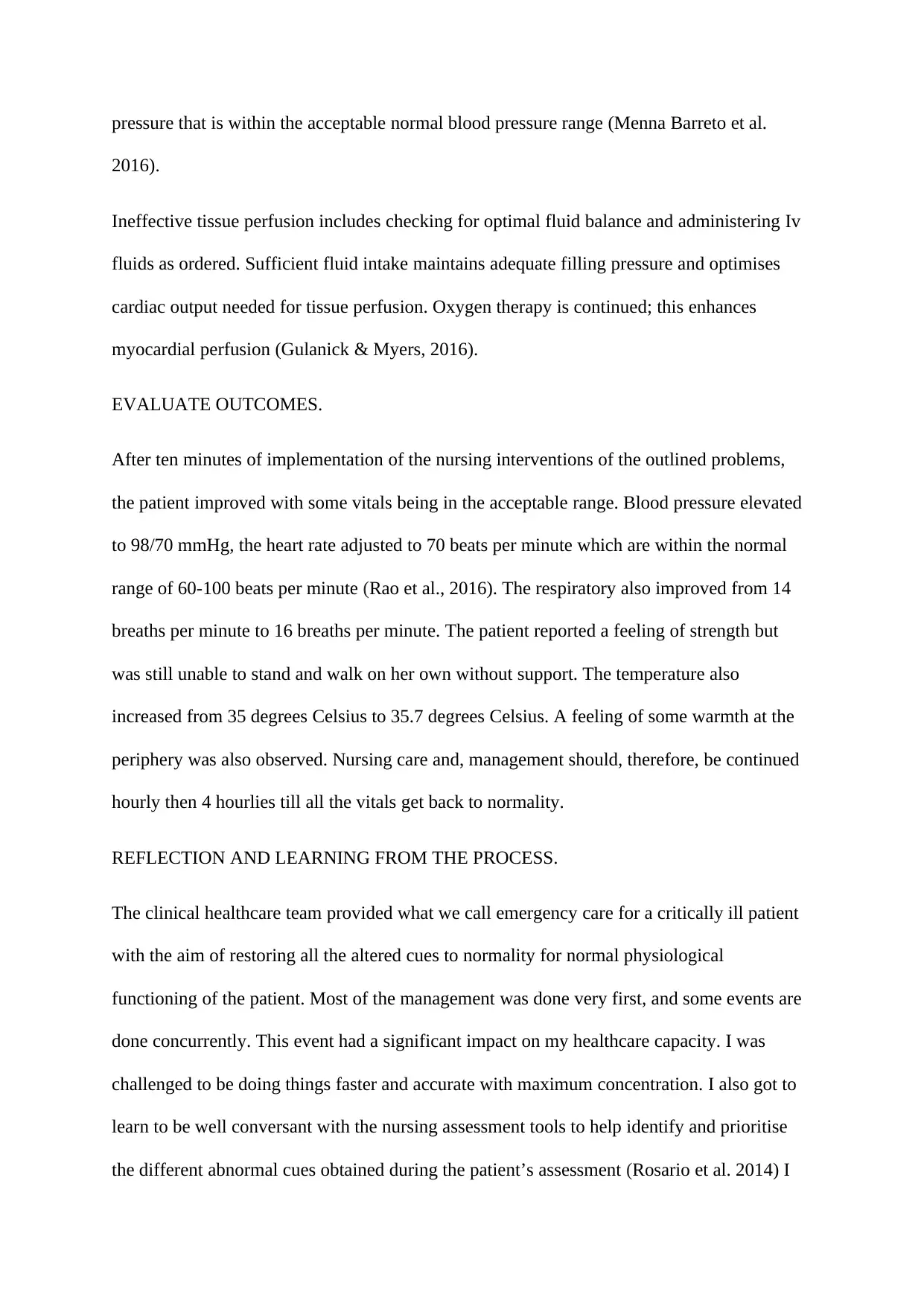
pressure that is within the acceptable normal blood pressure range (Menna Barreto et al.
2016).
Ineffective tissue perfusion includes checking for optimal fluid balance and administering Iv
fluids as ordered. Sufficient fluid intake maintains adequate filling pressure and optimises
cardiac output needed for tissue perfusion. Oxygen therapy is continued; this enhances
myocardial perfusion (Gulanick & Myers, 2016).
EVALUATE OUTCOMES.
After ten minutes of implementation of the nursing interventions of the outlined problems,
the patient improved with some vitals being in the acceptable range. Blood pressure elevated
to 98/70 mmHg, the heart rate adjusted to 70 beats per minute which are within the normal
range of 60-100 beats per minute (Rao et al., 2016). The respiratory also improved from 14
breaths per minute to 16 breaths per minute. The patient reported a feeling of strength but
was still unable to stand and walk on her own without support. The temperature also
increased from 35 degrees Celsius to 35.7 degrees Celsius. A feeling of some warmth at the
periphery was also observed. Nursing care and, management should, therefore, be continued
hourly then 4 hourlies till all the vitals get back to normality.
REFLECTION AND LEARNING FROM THE PROCESS.
The clinical healthcare team provided what we call emergency care for a critically ill patient
with the aim of restoring all the altered cues to normality for normal physiological
functioning of the patient. Most of the management was done very first, and some events are
done concurrently. This event had a significant impact on my healthcare capacity. I was
challenged to be doing things faster and accurate with maximum concentration. I also got to
learn to be well conversant with the nursing assessment tools to help identify and prioritise
the different abnormal cues obtained during the patient’s assessment (Rosario et al. 2014) I
2016).
Ineffective tissue perfusion includes checking for optimal fluid balance and administering Iv
fluids as ordered. Sufficient fluid intake maintains adequate filling pressure and optimises
cardiac output needed for tissue perfusion. Oxygen therapy is continued; this enhances
myocardial perfusion (Gulanick & Myers, 2016).
EVALUATE OUTCOMES.
After ten minutes of implementation of the nursing interventions of the outlined problems,
the patient improved with some vitals being in the acceptable range. Blood pressure elevated
to 98/70 mmHg, the heart rate adjusted to 70 beats per minute which are within the normal
range of 60-100 beats per minute (Rao et al., 2016). The respiratory also improved from 14
breaths per minute to 16 breaths per minute. The patient reported a feeling of strength but
was still unable to stand and walk on her own without support. The temperature also
increased from 35 degrees Celsius to 35.7 degrees Celsius. A feeling of some warmth at the
periphery was also observed. Nursing care and, management should, therefore, be continued
hourly then 4 hourlies till all the vitals get back to normality.
REFLECTION AND LEARNING FROM THE PROCESS.
The clinical healthcare team provided what we call emergency care for a critically ill patient
with the aim of restoring all the altered cues to normality for normal physiological
functioning of the patient. Most of the management was done very first, and some events are
done concurrently. This event had a significant impact on my healthcare capacity. I was
challenged to be doing things faster and accurate with maximum concentration. I also got to
learn to be well conversant with the nursing assessment tools to help identify and prioritise
the different abnormal cues obtained during the patient’s assessment (Rosario et al. 2014) I
⊘ This is a preview!⊘
Do you want full access?
Subscribe today to unlock all pages.

Trusted by 1+ million students worldwide
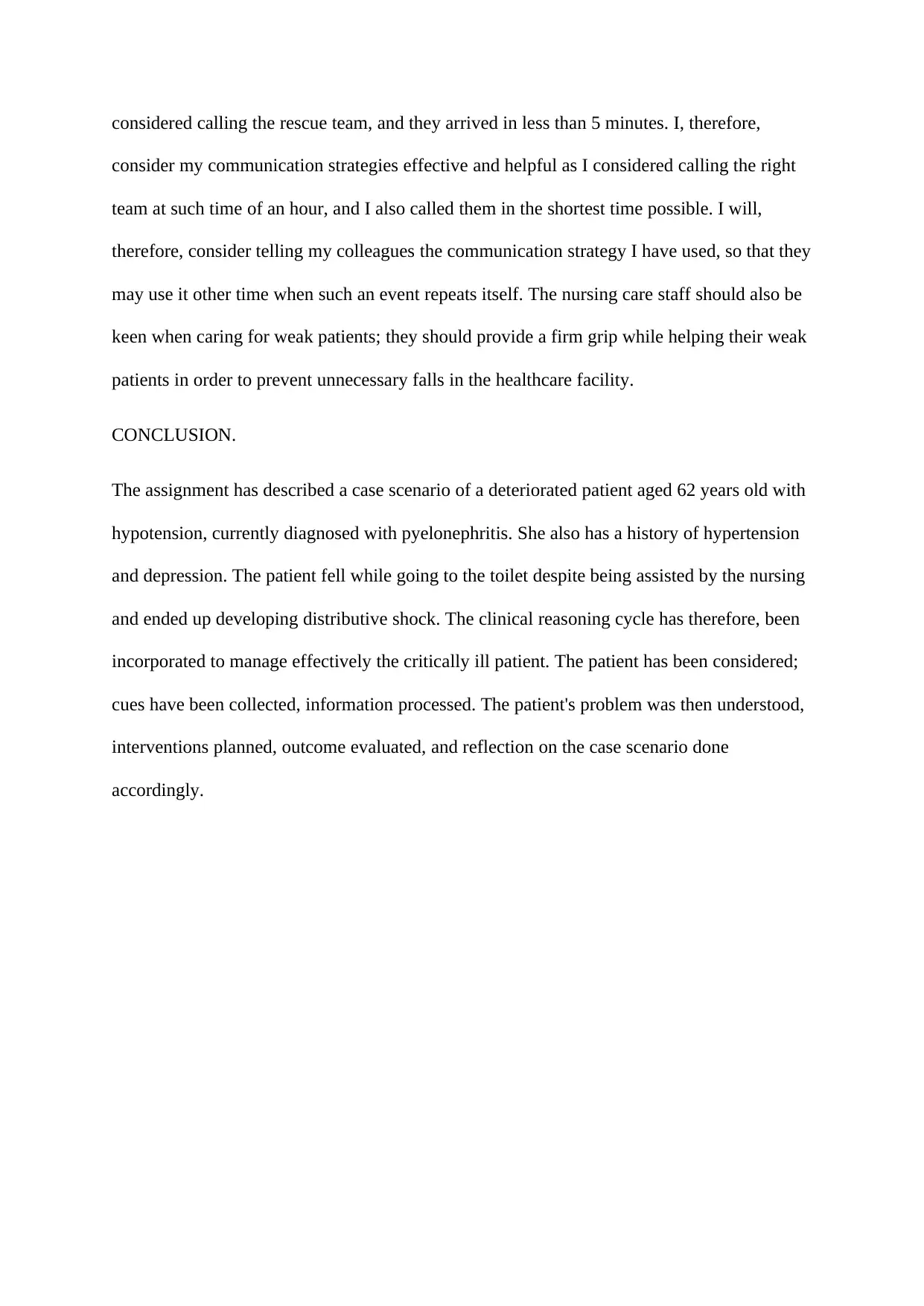
considered calling the rescue team, and they arrived in less than 5 minutes. I, therefore,
consider my communication strategies effective and helpful as I considered calling the right
team at such time of an hour, and I also called them in the shortest time possible. I will,
therefore, consider telling my colleagues the communication strategy I have used, so that they
may use it other time when such an event repeats itself. The nursing care staff should also be
keen when caring for weak patients; they should provide a firm grip while helping their weak
patients in order to prevent unnecessary falls in the healthcare facility.
CONCLUSION.
The assignment has described a case scenario of a deteriorated patient aged 62 years old with
hypotension, currently diagnosed with pyelonephritis. She also has a history of hypertension
and depression. The patient fell while going to the toilet despite being assisted by the nursing
and ended up developing distributive shock. The clinical reasoning cycle has therefore, been
incorporated to manage effectively the critically ill patient. The patient has been considered;
cues have been collected, information processed. The patient's problem was then understood,
interventions planned, outcome evaluated, and reflection on the case scenario done
accordingly.
consider my communication strategies effective and helpful as I considered calling the right
team at such time of an hour, and I also called them in the shortest time possible. I will,
therefore, consider telling my colleagues the communication strategy I have used, so that they
may use it other time when such an event repeats itself. The nursing care staff should also be
keen when caring for weak patients; they should provide a firm grip while helping their weak
patients in order to prevent unnecessary falls in the healthcare facility.
CONCLUSION.
The assignment has described a case scenario of a deteriorated patient aged 62 years old with
hypotension, currently diagnosed with pyelonephritis. She also has a history of hypertension
and depression. The patient fell while going to the toilet despite being assisted by the nursing
and ended up developing distributive shock. The clinical reasoning cycle has therefore, been
incorporated to manage effectively the critically ill patient. The patient has been considered;
cues have been collected, information processed. The patient's problem was then understood,
interventions planned, outcome evaluated, and reflection on the case scenario done
accordingly.
Paraphrase This Document
Need a fresh take? Get an instant paraphrase of this document with our AI Paraphraser
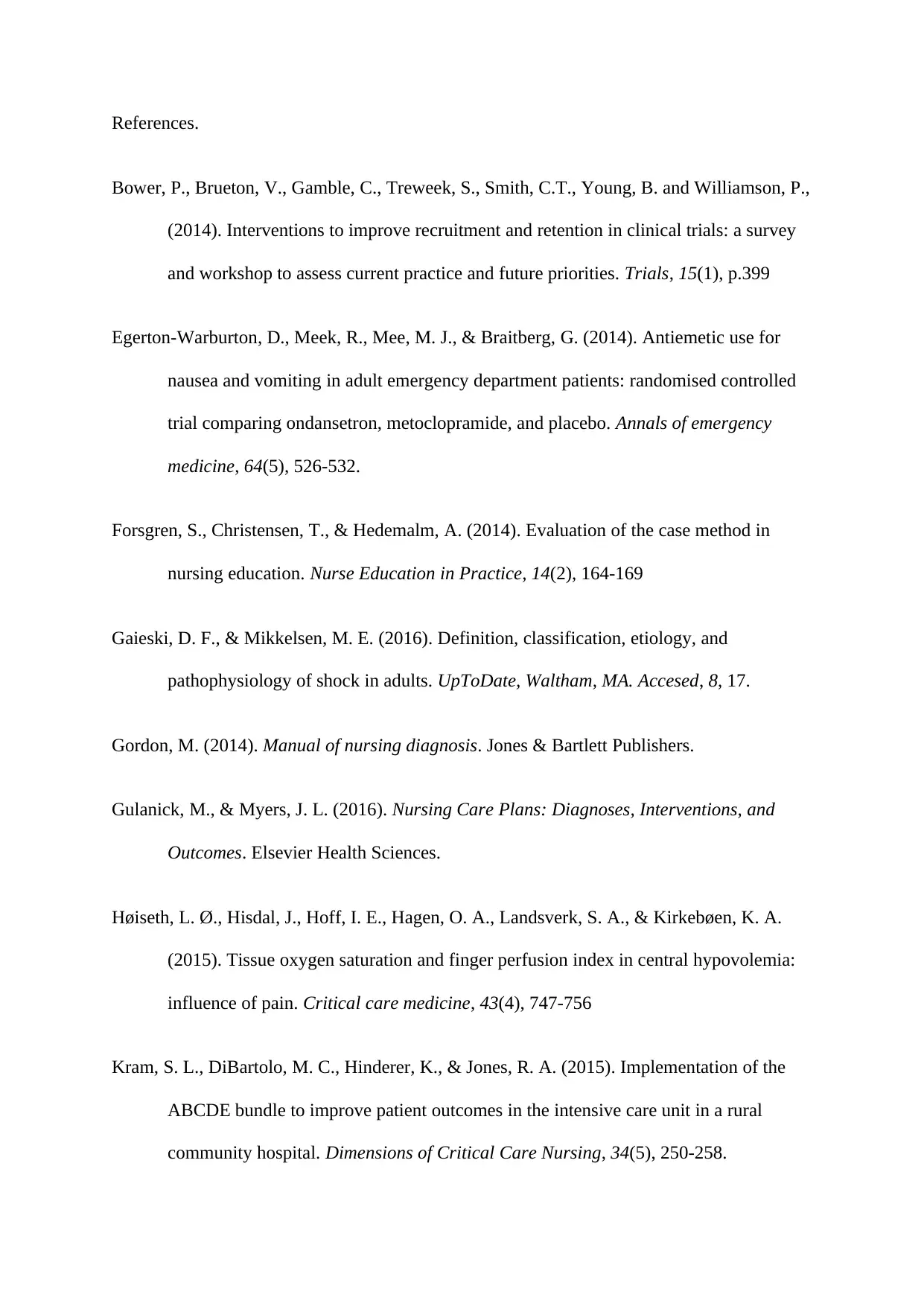
References.
Bower, P., Brueton, V., Gamble, C., Treweek, S., Smith, C.T., Young, B. and Williamson, P.,
(2014). Interventions to improve recruitment and retention in clinical trials: a survey
and workshop to assess current practice and future priorities. Trials, 15(1), p.399
Egerton-Warburton, D., Meek, R., Mee, M. J., & Braitberg, G. (2014). Antiemetic use for
nausea and vomiting in adult emergency department patients: randomised controlled
trial comparing ondansetron, metoclopramide, and placebo. Annals of emergency
medicine, 64(5), 526-532.
Forsgren, S., Christensen, T., & Hedemalm, A. (2014). Evaluation of the case method in
nursing education. Nurse Education in Practice, 14(2), 164-169
Gaieski, D. F., & Mikkelsen, M. E. (2016). Definition, classification, etiology, and
pathophysiology of shock in adults. UpToDate, Waltham, MA. Accesed, 8, 17.
Gordon, M. (2014). Manual of nursing diagnosis. Jones & Bartlett Publishers.
Gulanick, M., & Myers, J. L. (2016). Nursing Care Plans: Diagnoses, Interventions, and
Outcomes. Elsevier Health Sciences.
Høiseth, L. Ø., Hisdal, J., Hoff, I. E., Hagen, O. A., Landsverk, S. A., & Kirkebøen, K. A.
(2015). Tissue oxygen saturation and finger perfusion index in central hypovolemia:
influence of pain. Critical care medicine, 43(4), 747-756
Kram, S. L., DiBartolo, M. C., Hinderer, K., & Jones, R. A. (2015). Implementation of the
ABCDE bundle to improve patient outcomes in the intensive care unit in a rural
community hospital. Dimensions of Critical Care Nursing, 34(5), 250-258.
Bower, P., Brueton, V., Gamble, C., Treweek, S., Smith, C.T., Young, B. and Williamson, P.,
(2014). Interventions to improve recruitment and retention in clinical trials: a survey
and workshop to assess current practice and future priorities. Trials, 15(1), p.399
Egerton-Warburton, D., Meek, R., Mee, M. J., & Braitberg, G. (2014). Antiemetic use for
nausea and vomiting in adult emergency department patients: randomised controlled
trial comparing ondansetron, metoclopramide, and placebo. Annals of emergency
medicine, 64(5), 526-532.
Forsgren, S., Christensen, T., & Hedemalm, A. (2014). Evaluation of the case method in
nursing education. Nurse Education in Practice, 14(2), 164-169
Gaieski, D. F., & Mikkelsen, M. E. (2016). Definition, classification, etiology, and
pathophysiology of shock in adults. UpToDate, Waltham, MA. Accesed, 8, 17.
Gordon, M. (2014). Manual of nursing diagnosis. Jones & Bartlett Publishers.
Gulanick, M., & Myers, J. L. (2016). Nursing Care Plans: Diagnoses, Interventions, and
Outcomes. Elsevier Health Sciences.
Høiseth, L. Ø., Hisdal, J., Hoff, I. E., Hagen, O. A., Landsverk, S. A., & Kirkebøen, K. A.
(2015). Tissue oxygen saturation and finger perfusion index in central hypovolemia:
influence of pain. Critical care medicine, 43(4), 747-756
Kram, S. L., DiBartolo, M. C., Hinderer, K., & Jones, R. A. (2015). Implementation of the
ABCDE bundle to improve patient outcomes in the intensive care unit in a rural
community hospital. Dimensions of Critical Care Nursing, 34(5), 250-258.
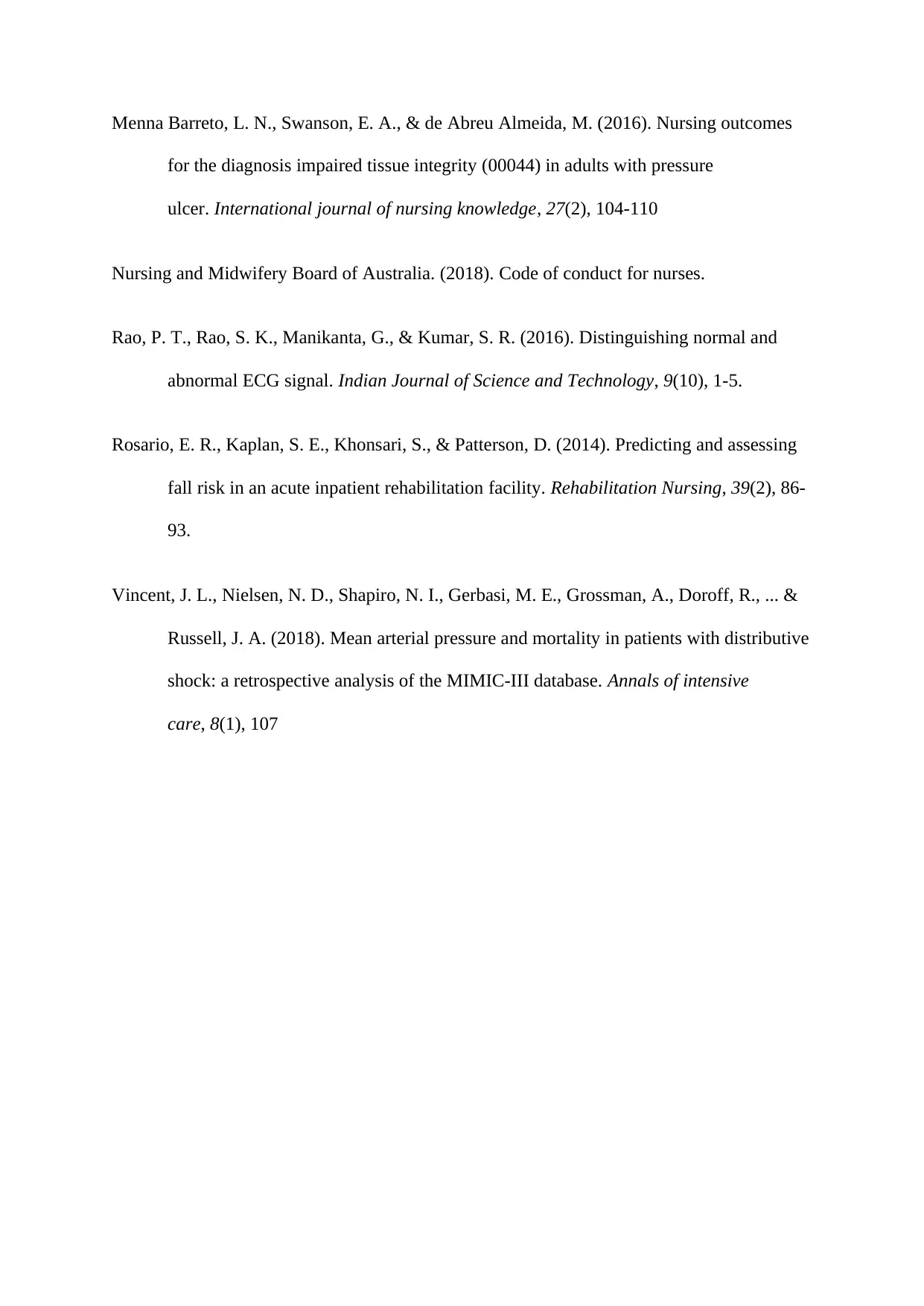
Menna Barreto, L. N., Swanson, E. A., & de Abreu Almeida, M. (2016). Nursing outcomes
for the diagnosis impaired tissue integrity (00044) in adults with pressure
ulcer. International journal of nursing knowledge, 27(2), 104-110
Nursing and Midwifery Board of Australia. (2018). Code of conduct for nurses.
Rao, P. T., Rao, S. K., Manikanta, G., & Kumar, S. R. (2016). Distinguishing normal and
abnormal ECG signal. Indian Journal of Science and Technology, 9(10), 1-5.
Rosario, E. R., Kaplan, S. E., Khonsari, S., & Patterson, D. (2014). Predicting and assessing
fall risk in an acute inpatient rehabilitation facility. Rehabilitation Nursing, 39(2), 86-
93.
Vincent, J. L., Nielsen, N. D., Shapiro, N. I., Gerbasi, M. E., Grossman, A., Doroff, R., ... &
Russell, J. A. (2018). Mean arterial pressure and mortality in patients with distributive
shock: a retrospective analysis of the MIMIC-III database. Annals of intensive
care, 8(1), 107
for the diagnosis impaired tissue integrity (00044) in adults with pressure
ulcer. International journal of nursing knowledge, 27(2), 104-110
Nursing and Midwifery Board of Australia. (2018). Code of conduct for nurses.
Rao, P. T., Rao, S. K., Manikanta, G., & Kumar, S. R. (2016). Distinguishing normal and
abnormal ECG signal. Indian Journal of Science and Technology, 9(10), 1-5.
Rosario, E. R., Kaplan, S. E., Khonsari, S., & Patterson, D. (2014). Predicting and assessing
fall risk in an acute inpatient rehabilitation facility. Rehabilitation Nursing, 39(2), 86-
93.
Vincent, J. L., Nielsen, N. D., Shapiro, N. I., Gerbasi, M. E., Grossman, A., Doroff, R., ... &
Russell, J. A. (2018). Mean arterial pressure and mortality in patients with distributive
shock: a retrospective analysis of the MIMIC-III database. Annals of intensive
care, 8(1), 107
⊘ This is a preview!⊘
Do you want full access?
Subscribe today to unlock all pages.

Trusted by 1+ million students worldwide
1 out of 9
Related Documents
Your All-in-One AI-Powered Toolkit for Academic Success.
+13062052269
info@desklib.com
Available 24*7 on WhatsApp / Email
![[object Object]](/_next/static/media/star-bottom.7253800d.svg)
Unlock your academic potential
Copyright © 2020–2025 A2Z Services. All Rights Reserved. Developed and managed by ZUCOL.





